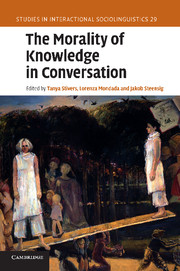Book contents
- Frontmatter
- Contents
- Contributors
- Preface
- Acknowledgements
- List of transcription and glossing symbols
- Part I Introduction
- Part II Affiliational consequences of managing epistemic asymmetries
- Part III Epistemic resources for managing affi liation and alignment
- 7 Territories of knowledge, territories of experience: empathic moments in interaction
- 8 The terms of not knowing
- 9 Proposing shared knowledge as a means of pursuing agreement
- 10 Ways of agreeing with negative stance taking
- 11 Epistemics and embodiment in the interactions of very young children
- Part IV Toward a framework
- References
- Index
11 - Epistemics and embodiment in the interactions of very young children
Published online by Cambridge University Press: 05 November 2011
- Frontmatter
- Contents
- Contributors
- Preface
- Acknowledgements
- List of transcription and glossing symbols
- Part I Introduction
- Part II Affiliational consequences of managing epistemic asymmetries
- Part III Epistemic resources for managing affi liation and alignment
- 7 Territories of knowledge, territories of experience: empathic moments in interaction
- 8 The terms of not knowing
- 9 Proposing shared knowledge as a means of pursuing agreement
- 10 Ways of agreeing with negative stance taking
- 11 Epistemics and embodiment in the interactions of very young children
- Part IV Toward a framework
- References
- Index
Summary
Introduction
A most fundamental kind of knowing is that which is based on what someone sees or experiences. Direct perceptual access to an event informs our knowledge and understanding of something that has transpired, and both entitles and obligates us to act and to tell others about it in particular ways. As the chapters in this volume demonstrate, one of the most basic and pervasive features of language use has to do with how participants design and implement their talk by reference to their own entitlements to knowledge, and what they figure others' to be. In this chapter, I examine how children aged 14 to 30 months, who are in the early stages of language use, come to have a practiced grasp of how knowledge matters for the organization of interaction – in particular, for how their own and others' differential access to an event motivates and shapes the lines of action they take.
For very young children, an understanding of the relationship between what someone sees and what they know is considered a developmental milestone, one that indexes a major cognitive shift in the way we understand other persons as intentional agents. A long line of research in developmental and cognitive psychology has been concerned with children's abilities to assess another person's knowledge based on his or her perceptual access to an event.
- Type
- Chapter
- Information
- The Morality of Knowledge in Conversation , pp. 257 - 282Publisher: Cambridge University PressPrint publication year: 2011
- 19
- Cited by

